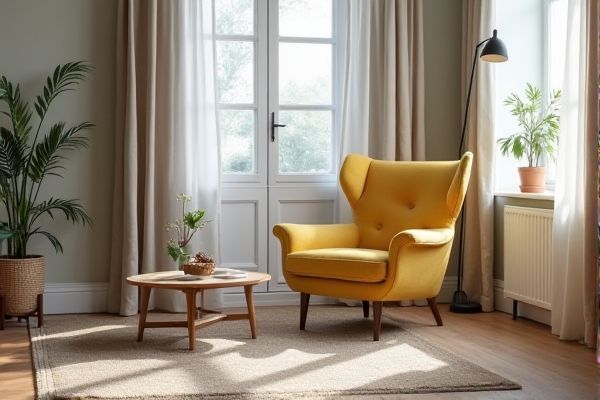
An armless chair offers a minimalist design that saves space and provides greater freedom of movement, while an armchair includes built-in armrests for added comfort and support during extended sitting. Explore the rest of the article to understand which option best suits Your needs and living space.
Table of Comparison
| Feature | Armless Chair | Armchair |
|---|---|---|
| Design | No armrests, sleek and minimal | Includes armrests, offers more support |
| Comfort | Less upper body support | Enhanced comfort with arm support |
| Space Efficiency | More compact, fits smaller areas | Bulkier, requires more space |
| Use Case | Dining rooms, offices, limited space | Living rooms, lounges, extended seating |
| Style | Simplistic, modern | Classic, traditional to modern |
| Price Range | Generally more affordable | Often priced higher due to added features |
Introduction to Armless Chairs and Armchairs
Armless chairs offer a minimalist design that maximizes space and flexibility, ideal for compact areas or multi-use rooms. Armchairs provide added comfort and support with built-in armrests, often serving as a focal point in living rooms and lounges. Both styles come in various materials and designs, catering to different aesthetics and functional needs.
Key Differences Between Armless Chairs and Armchairs
Armless chairs lack side supports, offering a minimalist design that enhances mobility and saves space, making them ideal for compact areas or multipurpose use. Armchairs feature integrated armrests that provide additional comfort and support, often used in living rooms or lounges for extended seating periods. The key differences lie in functionality, ergonomic support, and spatial requirements, influencing their suitability for different settings.
Design and Aesthetic Considerations
Armless chairs offer a sleek, minimalist design ideal for compact spaces and contemporary interiors, emphasizing clean lines and unobstructed silhouette. Armchairs provide a more traditional, cozy aesthetic with built-in armrests that enhance comfort and support while adding a sense of formality and presence to a room. The choice between armless and armchair designs significantly impacts visual flow and spatial dynamics, influencing both style cohesion and functional comfort in interior decor.
Comfort Comparison: Armless Chairs vs Armchairs
Armless chairs offer greater freedom of movement and are ideal for smaller spaces, providing a minimalist seating option without armrests. Armchairs deliver enhanced comfort and support through padded armrests, making them suitable for extended sitting periods and relaxation. The choice between the two depends on user preference for mobility versus ergonomic support and overall comfort needs.
Space and Versatility: Which Fits Better?
Armless chairs offer superior space efficiency, ideal for smaller rooms or tight seating arrangements, allowing easier movement and placement without bulk. Armchairs provide added comfort and support, enhancing relaxation but require more room due to their extended structure. You should choose based on your space constraints and versatility needs, with armless chairs maximizing capacity and armchairs prioritizing coziness.
Functionality and Practical Uses
Armless chairs offer greater mobility and space efficiency, making them ideal for compact areas and easy access in dining or office settings. Armchairs provide enhanced comfort and support with built-in armrests, perfect for relaxation or prolonged seating in living rooms and lounges. Your choice depends on whether functionality like maneuverability or comfort for extended use is a priority.
Ergonomics and Support Features
Armless chairs promote greater freedom of movement and are ideal for compact spaces, enhancing ergonomic flexibility by allowing users to easily shift positions without obstruction. Armchairs provide enhanced upper body support with padded armrests that help reduce shoulder and neck strain, contributing to improved posture during extended sitting periods. Selecting between an armless chair and an armchair depends on the balance required between space efficiency and the need for targeted ergonomic support features.
Best Rooms for Armless Chairs vs Armchairs
Armless chairs are ideal for smaller spaces like dining rooms, kitchens, or compact offices where maximizing seating without bulk is essential. Armchairs work best in living rooms, reading nooks, or bedrooms, providing extra comfort and a cozy, enveloping feel. Your room's function and space will determine whether the sleek design of an armless chair or the supportive embrace of an armchair is the better fit.
Maintenance and Durability
Armless chairs typically require less maintenance due to their simpler design and fewer components prone to wear, such as armrests, which can loosen or crack over time. Armchairs often feature additional padding and intricate upholstery that may need regular cleaning and repairs to maintain durability. Your choice should consider the higher upkeep demands of armchairs versus the straightforward durability of armless chairs.
Choosing the Right Chair for Your Needs
Armchairs provide added comfort and support with their side supports ideal for relaxing, while armless chairs offer greater mobility and space efficiency, perfect for smaller rooms or multifunctional setups. Your choice depends on whether you prioritize comfort and posture support versus versatility and ease of movement. Consider factors like room size, intended use, and ergonomic needs to select the chair that best suits your lifestyle and space.
 homyna.com
homyna.com